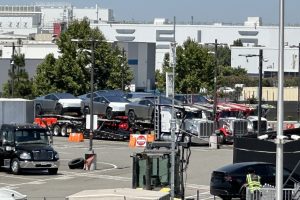- 🏭 Tesla is laying off more workers at its Gigafactory in Nevada, as part of the company’s efforts to trim its workforce globally.
- ✂️ The layoffs affect around 693 employees at the Nevada plant, which builds battery cells and is expanding for additional production lines.
- 👥 Along with the layoffs, three high-profile Tesla executives have departed recently, including Drew Baglino, Rohan Patel, and Martin Viecha.
- 💰 Tesla and Elon Musk have framed the layoffs as a necessary decision to restructure and streamline the company for its “next phase of growth.”
- 💸 The layoffs are expected to generate annual savings well in excess of $1.1 billion, according to Tesla’s Chief Financial Officer.
- 🤔 The article invites readers to share their thoughts on the layoffs and related developments.
Tesla, the pioneering electric vehicle manufacturer, has once again found itself in the headlines, but this time for reasons that might raise eyebrows among employees and industry observers alike. The company has announced a series of significant layoffs, primarily affecting its Nevada Gigafactory, which is responsible for producing battery cells and expanding production lines for the highly anticipated Tesla Semi.
The Nevada Layoffs: A Closer Look
According to recent reports, Tesla plans to lay off approximately 693 employees from its Nevada facility, a move that aligns with the company’s broader efforts to streamline its workforce globally. The decision was officially communicated to the Nevada Department of Employment, Training, and Rehabilitation, as mandated by the U.S. Worker Adjustment and Retraining Notification (WARN) Act.
While the layoffs may seem concerning at first glance, Tesla and its CEO, Elon Musk, have framed this decision as a necessary step to restructure and prepare the company for its “next phase of growth.” Musk has emphasized that such restructuring is a periodic necessity, occurring approximately every five years, to ensure the company remains agile and efficient in its operations.
Executive Departures: Changing of the Guard?
In addition to the layoffs, Tesla has also witnessed the departure of three high-profile executives: Drew Baglino, Senior Vice President of Powertrain and Energy Engineering; Rohan Patel, Vice President of Public Policy and Business Development; and Martin Viecha, Vice President of Investor Relations. These departures have fueled speculation about potential shifts in the company’s leadership and strategic direction.
Financial Implications and Future Growth
Tesla’s Chief Financial Officer, Vaibhav Taneja, has shed light on the financial implications of the restructuring efforts. According to Taneja, the layoffs are expected to generate annual savings well in excess of $1.1 billion, a substantial figure that underscores the company’s commitment to cost-cutting measures.
Musk and Tesla have consistently portrayed these actions as necessary for the company’s long-term growth and success. By streamlining operations and eliminating perceived redundancies, the company aims to position itself more effectively for its “next phase of growth,” a phrase that has been repeated by both Musk and Taneja.
Navigating Turbulent Times
While cost-cutting measures and workforce restructuring are common practices in the business world, Tesla’s actions have undoubtedly sparked a range of reactions and discussions within the industry and among stakeholders.
Some may view these moves as prudent steps to ensure the company’s financial stability and competitive edge, particularly in the rapidly evolving electric vehicle market. Others, however, may express concerns about the potential impact on employee morale, innovation, and the company’s ability to attract and retain top talent.
Looking Ahead: Balancing Efficiency and Innovation
As Tesla navigates these turbulent waters, it will be crucial for the company to strike a delicate balance between achieving operational efficiency and maintaining its innovative spirit. The electric vehicle industry is highly competitive, and Tesla’s success has been largely attributed to its ability to push boundaries and introduce game-changing technologies.
Moving forward, the company must carefully manage this transition, ensuring that the restructuring efforts do not inadvertently stifle the creativity and passion that have been the driving forces behind its remarkable achievements to date.





